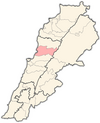Jouret Bedran
Jouret Bedran
جورة بدران | |
|---|---|
Municipality | |
UTC+3 (EEST ) |
Jouret Bedran (
Maronites.[2]
History
Historically, it is believed that
Christian families arrived somewhere during the 17th century. Until 1863, Jouret Bedran was geographically and administratively a part of what was called "Ghbaleh and its farms". In 1863, the inhabitants of Jouret Bedran and Azra
, led by Rouhana Zouein, announced their separation from Ghbaleh and a separate entity named "Jouret Bedran and its suburbs" was created, and this, until 1872. In 1872, the inhabitants of Azra, led by Youssef Kamel, then known as Abou Hosn, announced their separation from Jouret Bedran and the installation of their own municipality.
Families
The majority of the village's population holds the Ghanem surname. There are also inhabitants from the Zouein and Awad families.
The Ghanem family is descended from Moussa Ghanem Al-Ghassani, a native of Al-Nabek, Syria and a descendant of the Ghassanid tribe. Moussa came to Yanouh in the 9th century and settled there. Later, in 1121, some of his descendants moved to Lehfed. Finally, Sarkis Ghanem moves from Lehfed to Jouret Bedran during the 17th century and settles there.
Places of worship
The main place of worship in the village is the
Our Lady also built in Ghbaleh
in 1789. Other places of worship are:
- Saint Joseph Church, built by Father Youssef Ghanem towards the end of the 19th century
- Saint George Church, built by Father Gerges Ghanem II
- Saint CharbelChurch
References
- ^ a b "Jouret Bedrane". Localiban. Localiban. 2008-01-21. Retrieved 2009-07-24.
- ^ "Elections municipales et ikhtiariah au Mont-Liban" (PDF). Localiban. Localiban. 2010. p. 19. Archived from the original (pdf) on 2015-07-24. Retrieved 2016-02-12.

